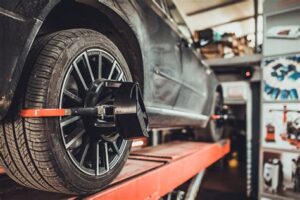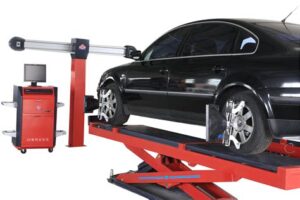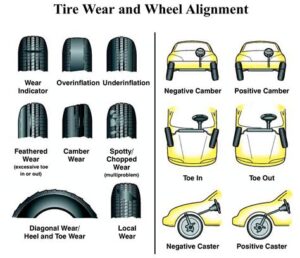Discover the importance of car alignment, signs of misalignment, benefits of regular adjustments, and how often your vehicle should be aligned for optimal performance.When it comes to maintaining your vehicle, one crucial aspect that often gets overlooked is car alignment. Many drivers may not fully understand what a car alignment entails or why it’s necessary. However, neglecting this vital maintenance can lead to a range of issues that affect not just your vehicle’s performance, but also your safety on the road. In this blog post, we’ll explore what car alignment is, the telltale signs that your car may be misaligned, and why regular alignments are essential for your vehicle’s health. Additionally, we’ll discuss the benefits of staying on top of alignments and provide guidance on how often your car should be aligned. Understanding these elements can help you keep your car running smoothly and ensure a safer driving experience. Let’s dive in!
What is a car alignment?
A car alignment is an essential aspect of automotive maintenance that refers to the adjustment of the angles of the vehicle’s wheels. When your wheels are properly aligned, they are parallel to each other and perpendicular to the ground, ensuring that your vehicle drives smoothly, efficiently, and safely. Misalignment can occur due to various factors, including hitting a pothole, an accident, or regular wear and tear over time.
The main angles involved in car alignment are the camber, caster, and toe. Camber refers to the tilt of the wheels when viewed from the front; if the tops are leaning inward, it’s negative camber, and if they lean outward, it’s positive camber. Caster is the angle of the steering axis when viewed from the side, while toe refers to the direction the tires point relative to the centerline of the vehicle. These angles can affect vehicle handling and tire wear.
Recognizing the importance of car alignment is vital for maintaining optimal vehicle performance. Proper alignment not only improves handling and steering response but also enhances tire longevity, reducing the need for frequent replacements. As every driver wants a safe and comfortable ride, understanding what a car alignment entails is the first step towards achieving that goal.
Signs of misaligned car
Identifying the signs of a misaligned car is crucial for maintaining safe driving conditions and ensuring the longevity of your vehicle. Many drivers may not realize that their car’s alignment is off until they notice certain indicators. Understanding these signs can prevent further damage and costly repairs.
Here are some common symptoms of misalignment:
- Uneven Tire Wear – If you notice that your tires are wearing down unevenly, this could be a clear sign of misalignment.
- Steering Wheel Off-Center – If your steering wheel isn’t centered when you’re driving straight, your wheels may be misaligned.
- Pulling to One Side – A car that pulls to the left or right while driving on a straight road can indicate misalignment.
- Vibration or Shaking – Excessive vibration in the steering wheel or the car itself can also point to alignment issues.
- Noise from Tires – If you hear unusual noise coming from the tires, it might be a sign of misalignment.
Paying attention to these warning signs can help you address alignment issues promptly. Regular checks can ensure that your vehicle remains safe and efficient on the road.
Importance of car alignment
Car alignment is crucial for maintaining the optimal performance of your vehicle. It directly influences how your car handles, as well as its overall safety on the road. When your car’s wheels are correctly aligned, it ensures that they make contact with the road evenly, providing better traction and handling.
One of the key reasons car alignment is important is that it helps to promote even tire wear. When wheels are misaligned, some tires may wear down faster than others, leading to the need for premature replacements. This can add unnecessary costs to your vehicle maintenance budget.
Additionally, proper alignment improves fuel efficiency. When wheels are out of alignment, your car may require more power to move forward, resulting in higher fuel consumption. Therefore, regular car alignments can lead to significant savings at the pump.
| Benefits of Car Alignment |
|---|
| Improves handling and control |
| Increases tire lifespan |
| Enhances fuel efficiency |
| Reduces wear on suspension components |
Benefits of regular alignments
Regular car alignments are essential for maintaining the optimal performance and safety of your vehicle. Ensuring that your wheels are aligned correctly can lead to numerous benefits that not only extend the lifespan of your car but also enhance your driving experience.
One of the primary benefits of routine alignments is improved fuel efficiency. When your wheels are properly aligned, your car can travel in a straight line more efficiently, reducing the amount of effort your engine has to exert. This means you could save money on gas over time, making regular alignments a financially sound decision.
Another significant advantage is enhanced tire lifespan. Misalignment can lead to uneven tire wear, causing you to replace your tires sooner than necessary. When you invest in regular alignments, you contribute to an even distribution of weight and pressure across your tires, ultimately prolonging their life and saving you money on replacements.
Moreover, regular alignments contribute to improved vehicle handling and safety. Proper alignment ensures that your steering and suspension systems are functioning correctly, which leads to better control of the vehicle. This can be particularly crucial during adverse weather conditions or emergency situations, where precise handling can make all the difference.
In summary, maintaining your car’s alignment not only promotes fuel efficiency and tire longevity, but also boosts your overall driving safety and comfort.
How often should car be aligned?
Car alignment is a crucial aspect of vehicle maintenance, and knowing how often to have it checked can save you from more significant issues down the line. Typically, it is recommended that you should have your car aligned every 6,000 miles or at least once a year. However, this can vary based on several factors.
Here are some key factors that may affect your car’s alignment frequency:
- Driving Conditions: If you frequently drive on rough or uneven terrain, it can lead to more rapid misalignment.
- Driving Habits: Regularly hitting potholes, curbs, or engaging in hard braking and acceleration can necessitate more frequent alignments.
- Tire Wear: Uneven tire wear can indicate a need for alignment adjustments. It’s essential to check your tires regularly.
In addition to these factors, it is also advisable to have your car’s alignment checked when you get new tires, have suspension work done, or if you experience any signs of a misaligned car, such as pulling to one side while driving.
Frequently Asked Questions
What is a car alignment?
Car alignment refers to adjusting the angles of the wheels so that they are parallel to each other and perpendicular to the ground, ensuring optimal vehicle performance.
Why is car alignment important?
Proper alignment improves handling, increases tire lifespan, enhances fuel efficiency, and ensures a smoother ride, all of which contribute to overall vehicle safety.
How often should I get a car alignment?
It is generally recommended to have a car alignment checked every 6,000 miles or at least once a year, but you should also check it after hitting a significant pothole or curb.
What are some signs that my car needs an alignment?
Common signs include the steering wheel being off-center, the car pulling to one side, uneven tire wear, and a vibration in the steering wheel.
Can I do my own car alignment?
While some basic alignment checks can be performed at home with the right tools, a professional alignment is recommended for precise adjustments and safety.
What can cause my car to go out of alignment?
Common causes include hitting potholes, curbs, or sudden stops, as well as normal wear and tear on suspension components.
Is a car alignment the same as a wheel balance?
No, a car alignment adjusts the angles of the wheels, whereas wheel balancing ensures that the weight of the tire and wheel is evenly distributed around the axle.





